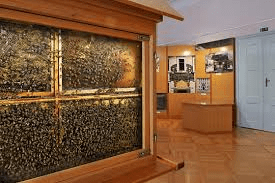The year 2018 has been designated as a ‘Year of Culture’ for Slovenian tourism. With this in mind, here’s a look at some of the numerous cultural attractions that the Radovljica area has to offer. Despite its modest size, as you will see, there are quite a few! I’m lucky enough to have them all right on my doorstep!
Linhart Square, the heart of Radovljica’s medieval old town, is home to the Šivec House Gallery, the Museum of Apiculture, and the Municipal Museum. The latter two are housed in the imposing Radovljica Mansion.

Photo: http://www.radolca.si
The Šivec House Gallery in Linhart Square is the place to be for all art lovers. One part of the gallery is dedicated to a permanent exhibition of original illustrations, whilst the other hosts monthly exhibitions by fine Slovenian and foreign artists. The building itself it also notable for its exterior fresco and the unusual layout and architecture of its preserved interior.
At the Museum of Apiculture, you can see a large collection of painted beehives front panels, including the oldest known in the world. Each of the painted panels tells a story.
The Lectar Gingerbread Museum and Workshop is located in the cellar of Gostilna Lectar, a family-run restaurant and guest house with a tradition dating back to 1766.
The current owners, Jože and Lili, have a real rags-to-riches story. When they first arrived in Radovljica to take over running Lectar Inn they initially had a lease to rent the restaurant for a 10-year period, however, it soon became apparent that it was to become their life’s work and that 10 years would be nowhere near enough, so they enquired about the possibility of buying the property. At that time, they certainly didn’t have the financial means to do so as they additionally had to put a lot of money, time and effort into renovating the 500-year old house and also had 2 young children (which later became 4 children – including one set of twins). Over time, all their hard graft began to pay off and nowadays, in addition to the family, they employ 17 staff across the restaurant, Lectar live gingerbread workshop and guest rooms.
Among the other cultural attractions in the Radovljica area are the Iron Forging Museum and the Fovšaritnica Museum House in Kropa.
The Museum of Hostages in Begunje, the Nativity Museum in Brezje, the Sextons’ Museum House in Kamna Gorica, the Mošnje Museum, and more…
Thanks to its favourable location and excellent transport links, Radovljica also makes an excellent base from where you can set off to discover more of Slovenia’s cultural attractions. Find out more here –
So, make 2018 a year to get to know more about Slovenia and its culture – after all, that is what makes every country unique!
© Adele in Slovenia













































